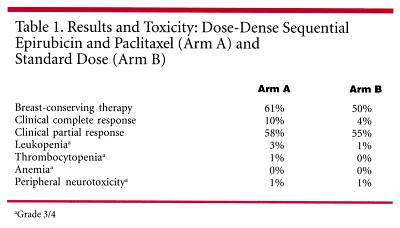Dose-Dense Sequential Epirubicin/Paclitaxel Raises Response in Primary Breast Cancer
MUNICH-Preoperative treatment of primary breast cancer with dose-dense sequential epirubicin (Ellence) and paclitaxel (Taxol) led to significant increases in breast-conserving therapy and in response rates compared to epirubicin and paclitaxel
MUNICHPreoperative treatment of primary breast cancer with dose-dense sequential epirubicin (Ellence) and paclitaxel (Taxol) led to significant increases in breast-conserving therapy and in response rates compared to epirubicin and paclitaxel at standard doses. A prospective randomized, controlled clinical trial conducted at multiple centers in Germany also found comparable toxicity between the two regimens (ASCO abstract 133).
After successful prior studies in the adjuvant setting, the trial was conducted in the neoadjuvant setting for four main reasons, stated the study’s lead investigator Michael Untch, MD, of Klinikum Grosshadern in Munich.
- Survival equivalence was demonstrated between preoperative and postoperative treatment.
- Retrospective and prospective evidence show increased rates of breast conserving surgery with neoadjuvant treatment.
- The pathologic complete response rate, defined by Dr. Untch as "no evidence of invasive cancer at primary tumor site," is a very good surrogate predictor of improved outcome.
- The preoperative setting provides a good model for investigating dose-dense chemotherapy.
Surgery After Chemotherapy
Speaking on behalf of the AGO Study Group (Arbeitsgemeinschaft Gynaekologische Onkologie), Dr. Untch said that patients received treatment with anthracyclines and taxanes, the two most potent classes of chemotherapeutic agents. They were randomly assigned to receive either: epirubicin at 150 mg/m², followed by paclitaxel at 250 mg/m², both 3 times every 2 weeks, with G-CSF (filgrastim) support (5 µg/kg/d) on days 3 to 10; or to receive epirubicin at 90 mg/m² and paclitaxel at 175 mg/m², 4 times every 3 weeks, as preoperative therapy.
For both groups, surgery was performed after completion of chemotherapy. All patients received CMF (cyclophosphamide, methotrexate, fluorouracil) 3 times every 4 weeks after surgery. Locoregional radiotherapy was also mandatory. Also, hormone receptor positive (HR+) patients received tamoxifen.
Included patients (n = 549, median age 50 years) had primary breast cancer (T > 3 cm or inflammatory disease) diagnosed by core biopsy and adequate clinical performance status (96.5% with Eastern Cooperative Oncology Group [ECOG] status 0). About 53% were premenopausal. The median tumor diameter was 4.2 cm (range 3.0-8.5 cm), and 16% of all patients had inflammatory disease. "We are dealing with large tumors, here," Dr. Untch commented. Fourteen and one-half percent had inflammatory disease.
Mastectomy was proposed in 74.5% of cases, and 64.5% were clinical node positive. Dr. Untch underscored that assessment was conducted not just by clinical palpation, but by mammography, MRI, and ultrasound before neoadjuvant therapy and before surgery.
Measurable Responses
In response analysis for 452 patients (see Table 1), measurable response occurred in 68% of patients in the dose-dense sequential arm, 10% clinical complete response (CRR) and 58% clinical partial response (CPR). In the epirubicin/paclitaxel standard dose arm, the measurable response occurred in 59%, 4% CCR and 55% CPR (
P
= .03). Calculating pathologic response according to various criteria confirmed a dose-sequential advantage, and using the most common definition (ypTO pTis [no invasive cancer cells with some in situ component at the primary tumor site]) showed a rate of 19% for dose-dense treatment vs 10% for standard dose (
P
= .006).

Breast conserving therapy was performed in 61% of patients receiving the dose-dense regimen as compared with 50% for the epirubicin/paclitaxel standard arm (P = .02). Lumpectomy with free margins was noted in 40% of dose-dense patients and 25% of standard dose patients. Histologically negative nodes were found in 50% of the dose-dense arm and 41% of the standard arm.
Toxicity results were available for 549 patients. While there were no significant differences in grade 3/4 hematologic toxicities (see Table 1), rates of thrombocytopenia were higher in the dose sequential arm (9% vs 2%) as were rates for anemia (44% vs 22%). Leukopenia was higher for standard dose epirubicin/paclitaxel (77% vs 43%). These patients did not receive prophylactic G-CSF, Dr. Untch noted. There were no differences in nonhematologic toxicities. Dose reductions were required in 4% of the cycles of dose-dense patients and 1% of standard dose cycles.
Further Follow-Up Awaited
"Dose-dense sequential application of epirubicin and paclitaxel with G-CSF as preoperative treatment of primary breast cancer resulted in a significant increase in rates of measurable response, pathologic complete response, histologically negative nodes, and breast conservation," Dr. Untch concluded. "Nevertheless, we have to wait for further follow-up to correlate these factors with disease-free and overall survival."
Commenting on response assessment modalities, Dr. Untch pointed out that while MRI is the most "stringent" among them, it is not generally available outside of clinical trials. "Sonography is a very good tool for downstaging of the tumor at the primary siteand also for lymph nodes on the axilla," he said.